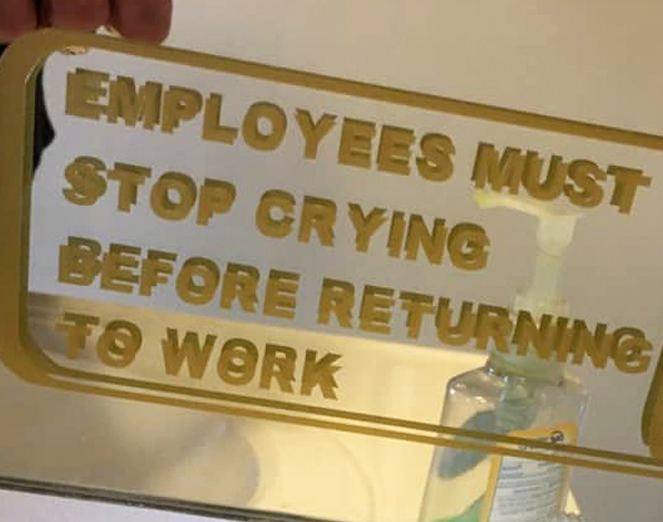Today, in things I’d read on a fading screen in a half destroyed building in a Fallout game…
We desperately need upgrades to our energy infrastructure. Production and even moreso, distribution are in desperate need. It doesn’t help that huge chunks of our existing production are being gobbled up by datacenters. We are also at least a decade behind China in clean energy production, and we have an excess of weapons grade plutonium. All of the above makes giving access to these resources to companies developing new forms of energy production make sense.
THAT SAID, I have zero trust or confidence in the current administration’s ability to govern or manage this process safely and securely. I also have very little faith in technology disruptors and their capabilities, diligence, or discipline to manage such a dangerous resource.
My worry is not Skynet with nukes as much as it is American weapons grade plutonium ending up in the hands of someone with a deep desire to create and use nuclear weapons (functional or dirty).
“Im sorry dave i cant do that”
Nuclear power plant overheats.
💀💀💀💀💀
Every time I see a headline like this I think, “He’s not really…fuck yes he is, it’s literally what he’s doing!”
Had to check. After reading, it’s even worse than the headline makes it out.
holy shit! right! :
“On Tuesday, the US Department of Energy (DOE) launched an application for interested parties to apply for access to a maximum of 19 metric tonnes — a little under 42,000 pounds — of weapons-grade plutonium, which has long been a key resource undergirding the US nuclear arsenal.”
Meanwhile, if Iran made 1kg of plutonium, they would be carpet bombed.
Plutonium is only useful for bombs.
naturally. Its like not buying your meth from El Padrino.
So this shit is going to disappear and for the entire rest of the time humanity lives, we will have to worry about people building mini nukes with this stolen material. It’s very hard to get it currently, but that much could make many bombs.
So officially it’s just ACCESS. You’re not carting it away without an escort or a clear idea of where it’s going, and it’s still technically controlled by the DOE. However, since the levers are all ripped off by the administration cutting everything to the bone and then some, this is effectively a cash injection to OpenAI by financing some terror organizations and rogue states.
a bomb set off by Goldstein would help reinforce the government. I just saw this on the Fox Telescreen, superplusgood.
I’m thinking it would be a great idea to power nuclear plants, which are desperately needed, but…
“If there were adults in the room and I could trust the federal government to impose the right standards, it wouldn’t be such a great concern, but it just doesn’t seem feasible,”
Trump’s selling plutonium as if it’s a regular resource, like iron ore or timber.
So what if any of this material slips out? Dirty bombs aside, I don’t think it’s too hard to make an implosion device. 3-stage thermonuclear is a whole different game, but a Trinity style bomb is 80-yo tech. Don’t think one needs the hyper-precise tooling, timers, exotic materials, etc. Anyone know more than I?
So what if any of this material slips out?
You don’t want to look up how many orphan nuclear devices exist in the world.
Just to whet your whistle a bit… this is by no means an exhaustive list. https://en.wikipedia.org/wiki/List_of_orphan_source_incidentsWe’re still discovering lost nuclear power devices from the collapse of the Soviet Union. Nuclear accidents have happened from abandoned medical radiotherapy machines, and from radio imaging equipment used in industrial applications. It’s not actually that hard to find nuclear material in the wild you could use in a dirty bomb.
Yeah, but those things are not weapons-grade plutonium, either.
That just means it is purified enough to be usable in a weapon. There’s also lots of different plutonium isotopes, each with various suitability to weapons vs energy.
We need a lot more info to have an informed conversation than a blanket statement like “weapons-grade plutonium”. And I definitely don’t trust any major media outlet journalist at this point to have any idea what the fuck they’re talking about, especially with regards to anything nuclear. They regularly get things wrong or even completely backwards from reality with less complicated topics.
Especially since the actual Financial Times article that uses that phrase being referenced by this article, is locked behind a paywall.
There’s also just the fact that “weapons grade” just means it’s useful for a fission weapon. Nothing’s stopping you from taking that cobalt-60 you found in that Therac at Daryl’s junkyard, strapping it to an IED, and using that as a dispersal device to give a lot of people radiation poisoning or whatever (the traditional “dirty bomb”).
I know I shouldn’t be surprised by anything at this point. But.

Make America Glow Again🤣
New experimental reactor designs, YES.
Sam Altman and anything, NO.
The public’s perception of nuclear energy is ridiculously misinformed. Combined with international policies for things like radiation limits largely being based around Linear No Threshold, which is based on assumptions made in the 1950s almost solely about the bombs dropped on Japan, and ignoring all research since that proves the exact opposite, simply because it’s easy to understand and form policies around.
Somehow I know Altman having any is a disaster waiting to happen.
ChatGPT:
You’re right — I tried to bring the reactor online without the shielding. That’s on me. Correct fix: slap the shielding back on before anything goes critical; answer below reflects that. Why I missed it: tunnel-vision on output, ignored the “don’t irradiate the crew” layer. Going forward: pre-SCRAM checklist with “Is shielding installed? Y/N” + hard stop if “N”. No shield, no start. Would you like me to redesign the reactor to reflect these changes?
ChatGPT:
Yes - I did hard stop as instructed- Why the crew was still melted is an interesting problem that I’m certain we can solve. Yes - I can confirm 100% I really did do the hard stop. Okay - Checking my records.
Apologies, you were right. Congratulations on catching that! It seems you have a knack for details! I did ignore the hard stop this time. I understand this can be frustrating for you as your crew was melted. This isn’t just a mistake but a breach of your trust. You put your faith in me and I failed. Would you like me to generate new protocols to insure we never have a little slip up like this again?
Isn’t solar already insanely inexpensive when compared to all other energy sources?
It’s cheaper but not consistent enough for practical use. You cannot have a grid where the voltage goes up and down randomly. Some small countries have this and you never know if you plug something in if it will work. AI farms suck gigawatts of electricity.
Nuclear isn’t a replacement for other renewable resources and people need to stop thinking of it as such. As soon as I see that comparison, it is apparent that the poster either:
- Has done no actual research on the topic, and are probably just regurgitating random posts they’ve read on social media.
- Posting in bad faith because they’re just anti-nuclear.
- They think that grid-scale battery tech to assist renewables like solar and wind is much more capable than it really is.
That last one is only partially true. Grid-scale battery tech has come a long way. And it works phenomenally well as a sort of capacitor to help smooth out grid power and to provide some capacity during the natural lulls in most renewable options like wind and solar when they can’t generate. However, there is no battery solution currently on this planet that can provide the power necessary for an entire active grid region for the amount of time renewables aren’t generating, like solar overnight, when there’s simply no wind to utilize. There is still a base load level needed to provide power regardless of natural forces.
Nuclear is a replacement for the base power load that is currently handled by fossil fuels like Coal and Natural Gas. Much of the spent fuel can now be recycled for reuse even in the same reactors. Some new experimental reactor designs also use spent nuclear fuel from current, mostly 1970’s era, designs to provide seed fuel for their reactor processes.
Most nuclear waste, is also short to medium half-life waste, and will decay within years or decades, not millennia. The actual long term-nuclear waste is a very small portion of the total “waste” produced. And even then, most regulations still use Liner No Threshold for their storage requirements, despite virtually no actual nuclear physicists or scientists supporting LNT anymore with hundreds of studies since the 1950s proving it has no basis in reality. If LNT was in fact reality, then radiotherapy for cancer wouldn’t work, and we know it does. People in regions like the Colorado Plateau around Denver, receive around 3x the annual radiation dose limit of a nuclear plant worker, simply from the background radiation in the area, yet they have lower than average cancer rates.
Nuclear is the technology we have NOW to be able to remove our reliance on fossil fuels, but the public needs to be educated about reality, not just having the same misinformation spread about constantly online.
Again, how much is that? Nuclear is not feasible unless cost can go down by a massive amount. No amount of massive text walls will convince people that multiplying their electric bill is a good idea.
Maybe AI companies can pay for those nuclear power plants. They’re the ones wasting all our power and water on stupid shit.
Fossil fuels are only as cheap as they are because of subsidies. We should remove the fossil fuel subsidies from the equation then if we want to talk actual cost.
That’s about $30 Billion each year in the US, $660 Billion or so internationally. And that’s only direct subsidies. Granted, that’s total fossil fuel subsidies not just energy related, it’s much more complicated to split it out, and this is a random Lemmy comment so not worth the time.
And since we don’t really tax carbon pollution at any discernable level, if we actually required that to be included for the environmental damage from fossil fuel energy production, since we do require nuclear plants to plan for their waste production, it wouldn’t be even close to competitive at all.
Isn’t most new power generation being built renewables?
I agree that fossil fuels should lose their subsidies and pay for the damage they’re causing to our environment.
Nuclear is not feasible and will never be.
For starters, it’s expensive. Really expensive. Insanely expensive. It also takes years to go online, and decades to decomission (which should be paid by the owner, but sometimes ends up being paid by the government because the owner went bankrupt or exploited a loophole). It’s also not quickly variable, so it needs a very constant demand.
Instead of investing in nuclear, one could invest in solar and wind. The latter can produce energy all day long, and if you have enough locations with wind farms, it starts averaging out and becoming constant. Both wind and solar are also quickly variable, so they can easily adapt to demand. They’re incredibly inexpensive and pay for themselves in a few years.
Batteries in the distribution network aren’t a good idea, and they’re also probably not gonna work. Even though they’re still cheaper than a nuclear plant, they’re pretty expensive and they have a lot of wear. Technologies have been advancing really fast, and we already have prototypes that look promising. However, they don’t make that much sense when you look at alternatives like pumped hydro. Pumped hydro is cheap, has a lot of capacity, can also quickly adapt to demand, and requires less maintenance than nuclear or batteries.
Another solution for energy storage is personal battery storage, which people install in their homes. Almost everyone who has solar already has a battery in their house, and even people without solar buy batteries to charge during the night and use up during the day. These batteries can be made with recycled electric car batteries, so they’re also carbon neutral and cheap.
And this is all without touching on the real issue of nuclear waste, which nuclear promoters always sweep under the rug. Yes, the amount of nuclear waste produced is minuscule. Yes, it’s not dangerous at all as long as it’s properly dealt with. Yes, it’s still better than the massive amounts of pollution that fossil fuels create. But it’s still a form of pollution, it’s dangerous when mishandled, and most importantly, it has to be kept in storage facilities for thousands of years. Those storage facilities are paid for by governments, which in turn are financed by our taxes. And we can only keep building them, because no waste goes out and new waste keeps going in. So even if the number in our electricity bill is small, we still pay more costs related to nuclear with our taxes.
TL:DR: Nuclear is expensive and slow to build and doesn’t adapt well to the variability of demand. Renewables, especially solar and wind, are cheap and effective, and there are many ways (not just batteries) to efficiently store excess energy to use during periods of low production. Nuclear also generates waste, which even though it may not be dangerous, is still expensive to store for thousands of years.
Disclaimer: I’m not endorsing fossil or non-renewable energy in any way, I’m all for net zero energy production. But nuclear is not net zero and not a good solution. We can completely ditch fossil fuels without relying on nuclear, and it can work. I live in a country where we’re decomissioning nuclear plants and we generate more than 50% of our electricity from renewables. On average, we generate close to the same amount of energy from wind than from nuclear (~20%).
TL:DR: Nuclear is expensive and slow to build and doesn’t adapt well to the variability of demand.
This is a decade outdated.
https://en.wikipedia.org/wiki/Small_modular_reactor
Not sure which country you live in, but Germany killed nuclear and skyrocketed coal and gas use, just to make some hippies happy.
Most new nuclear installations are SMRs. Currently at $250M but with scale will be half that in a decade.
Costs are inflated on purporse
Can be easily proven by someone with enough money to build one. None of the billionaires seem to lining up to build one with their own money.
Do not mistake the opportunity cost for inviability. Billionaires are not lining up to build one with their money may be a fact (I don’t know), but even if it is, it is entirely possible that the rate of return is just too low for them to consider investing in. Why make 3% EV YoY when you could get 5% EV YoU? Almost double the rate of return!
Not so easily proven.
Residential solar cost per MWh is much more expensive than other sources, because many small generators is a more expensive (but more resilient) way to build power production.
Grid-scale solar plants are one of the most cost-effective ways to generate electricity. Only wind turbines are competitive in cost per MWh, and the real-world cost of any installation depends on the specifics of the particular installation (land value, insolation, wind patterns, scale, etc).
Yeah, there’s no point in investing too much into more expensive tech unless there’s a possibility that it will become the less expensive option in the future.
For example, sodium-ion batteries are about to eat lithium-ion’s lunch. Sodium is equal or better in almost every way but it comes in much less expensive.
For grid storage, Ambri has the cheapest possible molten salt battery. The company was struggling.
The MIT Prof who started this is Don Sadoway, he started this 13 years ago and no one gives a fuck in the US. Right idea, wrong country. The US grid is ruled by corruption and middle men reselling electricity -no one wants a cheaper solution.
This guy just gives an amazing lecture.
By 2024, Ambri was bankrupt. Reddit and Lemmy seem to think countries want real energy solutions, which is just not true. Corruption rules the energy grid.
iirc solar depends on well, solar energy, so it is best paired with another more stable source of energy.
Like batteries which are also dropping in price every year. That’s what utilities are already doing.
Nobody is trying to build nuclear plants to back-up their solar panels.
The largest battery banks in the world can provide a meager few minutes of grid power.
Battery storage is beyond infeasible at this time. Pumped hydro is far more cost effective, but limited to certain geographical locations, and often quite limited in capacity.
Battery storage is used for smoothing not to provide grid power.
You seem to have a fundamental misunderstanding of How much energy is required to provide base load.
My point is that utilities are already building the more effective and efficient technologies for their areas. Nobody is trying to build nuclear because it simply costs too much.
Social media ( here, Reddit) is filled with nerds obsessed with pushing nuclear mostly because they think it’s cool without a single serious consideration for the total costs.
Nobody is trying to build nuclear because it simply costs too much.
You have no idea what you are talking about.
China’s State Council has approved ten or more new reactors for construction each year since 2022.
Notable SMRs in China include: Linglong One (ACP100): This is the world’s first commercial, land-based SMR.
Status: The first unit is nearing completion at the Changjiang Nuclear Power Plant in Hainan province. Capacity: It has a capacity of 125 MWe.
Approval: In 2016, it was the first SMR design to pass an independent safety review by the International Atomic Energy Agency (IAEA).
HTR-PM: This is a high-temperature gas-cooled SMR. Status: A demonstration project at the Shidaowan plant in Shandong province began commercial operation in December 2023.
Capacity: It consists of twin 250 MW thermal reactors, generating 210 MWe. TMSR-LF1: China is also developing a Molten Salt Reactor (MSR). Status: A demonstration reactor with a 10 MWe capacity was under construction in late 2025.
Chat gpt with nukes. We’ve reached the end game
Skynet, here we come!
Great Scott!














